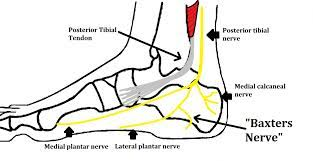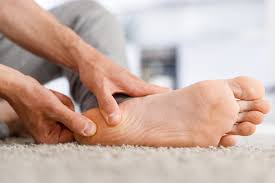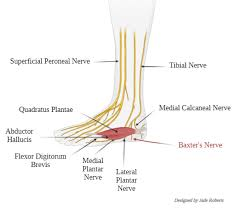Baxter’s Nerve Entrapment: Identifying and Managing this Hidden Heel Menace
Walking, running, and even standing – seemingly simple activities that we often take for granted, can become excruciatingly challenging when heel pain strikes.
While plantar fasciitis frequently claims the spotlight as the primary culprit behind heel discomfort, another often overlooked and elusive condition, Baxter’s nerve entrapment, lurks in the shadows, causing its fair share of agony.
Baxter’s nerve, a branch of the lateral plantar nerve, weaves its way beneath the heel, tasked with transmitting vital sensory and motor signals. However, this unassuming nerve can fall victim to compression, leading to a cascade of symptoms that closely mimic plantar fasciitis, making diagnosis a daunting task.
In this article, we embark on an enlightening journey to unmask the enigma of Baxter’s nerve entrapment. We will explore the key clinical indicators that differentiate this condition from other heel-related maladies, unraveling the intricacies of proper identification. Understanding the distinct symptoms and conducting meticulous assessments is essential to ensure targeted and effective management strategies.
If you’ve been experiencing heel pain, keep reading to learn how it may be caused.
What is Baxter’s nerve entrapment and what causes it?
Baxter’s nerve entrapment, also known as Baxter’s neuropathy, occurs when the small nerve that runs along the outside of the heel becomes compressed or irritated.
This nerve is known as the inferior calcalenal nerve and it is a branch of the lateral plantar nerve.
This compression is often caused by repetitive trauma, such as excessive running or wearing tight shoes. In some cases, anatomical factors like a flat foot or heel spurs can also contribute to the condition.
What are the common symptoms of Baxter’s nerve entrapment?
The symptoms of Baxter’s nerve entrapment typically include pain and tenderness on the outside of the heel, along with a tingling or burning sensation and intermittent very sharp almost electric shock type pain in the heel.
Some individuals may also experience numbness or a pins-and-needles sensation in the area. Unlike plantar fasciitis pain which is normally worse first thing in the morning or after periods of rest, Baxter’s nerve entrapment pain can worsen with activity, particularly when walking or running and towards the end of the day.
How is Baxter’s nerve entrapment diagnosed by podiatrists?
Podiatrists diagnose Baxter’s nerve entrapment through a combination of physical examination and medical history review. They will assess the affected area, checking for tenderness, swelling, and any abnormal sensations. Imaging tests such as ultrasound or MRI may be used to further evaluate the condition and rule out other potential causes of heel pain.
What treatment options are available for relieving Baxter’s nerve entrapment?
Treatment options for Baxter’s nerve entrapment vary depending on the severity of the condition.
In mild cases there are a number of treatment options that can be utilised as part of your management plan including:
In more severe or persistent cases, corticosteroid injections, hyrdodilation therapy or surgical intervention may be considered to release the compressed nerve.
What is the recovery time for Baxter’s nerve entrapment after surgical intervention vs non surgical?
The recovery time for Baxter’s nerve entrapment after surgical intervention can vary depending on the individual and the extent of the procedure.
Generally, it may take several weeks to a few months for complete recovery. After surgery, a period of immobilisation and limited weight-bearing is typically required to allow the affected area to heal.
Physical therapy and rehabilitation exercises are then introduced gradually to restore strength, flexibility, and function to the foot. It’s important to follow the post-operative instructions provided by your podiatrist and attend follow-up appointments to monitor your progress and ensure a successful recovery.
In conservative or non-surgical treatments provided the treatment results in improvement the improvement is normally quicker and occurs over several weeks.
Are there any preventive measures to avoid Baxter’s nerve entrapment?
While Baxter’s nerve entrapment cannot always be prevented, there are some measures that may help reduce the risk or severity of the condition. Wearing properly fitting shoes that provide adequate support and cushioning can help minimise repetitive trauma to the foot.
Avoiding high-impact activities or excessive running on hard surfaces can also help reduce the risk of nerve compression. Regularly performing stretching exercises for the feet and calves can help maintain flexibility and reduce tension in the area. If you have certain anatomical factors that may contribute to Baxter’s nerve entrapment, such as flat feet or heel spurs, seeking advice from a podiatrist and using orthotic inserts or arch supports may be beneficial in preventing or managing the condition.
Can wearing certain types of footwear contribute to Baxter’s nerve entrapment?
Yes, certain types of footwear can contribute to Baxter’s nerve entrapment by causing increased pressure or compression on the nerve.
Shoes that lack adequate arch support and cushion can lead to baxters nerve entrapments. It’s important to choose shoes that provide adequate room for the toes to move freely and have proper arch support. Opt for shoes with cushioned soles that absorb shock and distribute pressure evenly across the foot. Look for designs that prioritise comfort and provide ample space in the toe box.
Consulting with a podiatrist can help you determine the best footwear options based on your specific needs and foot structure.
What exercises or stretches can help alleviate the symptoms of Baxter’s nerve entrapment?
When it comes to exercises or stretches for Baxter’s nerve entrapment, there are a few that can help alleviate symptoms, including:
- Calf stretches, such as standing with one foot forward and leaning against a wall with the back leg straight, can help maintain flexibility in the calf muscles and reduce tension on the nerve.
- Toe curls and toe scrunches using a towel can strengthen the foot muscles and improve overall foot function. Additionally, massaging the affected area with a tennis ball or frozen water bottle can provide temporary relief by reducing inflammation and promoting circulation.
It’s important to consult with a podiatrist or physical therapist before starting any exercise regimen to ensure they are appropriate for your condition and to receive proper guidance on technique and frequency.
Baxter’s nerve entrapment is a condition that can cause heel pain and discomfort, but with proper diagnosis and treatment, relief is possible. By working closely with a podiatrist, you can explore various treatment options, from non-surgical approaches to surgical intervention when necessary. Additionally, implementing preventive measures, such as wearing well-fitting shoes and engaging in appropriate stretching exercises, can help reduce the risk of developing Baxter’s nerve entrapment or prevent its recurrence. Remember to listen to your body, seek professional advice, and stay proactive in taking care of your foot health.
If you’re experiencing heel pain, come talk to us here at Hurst Podiatry, We can assess you and provide you with treatment options to ensure you can manage your condition.






